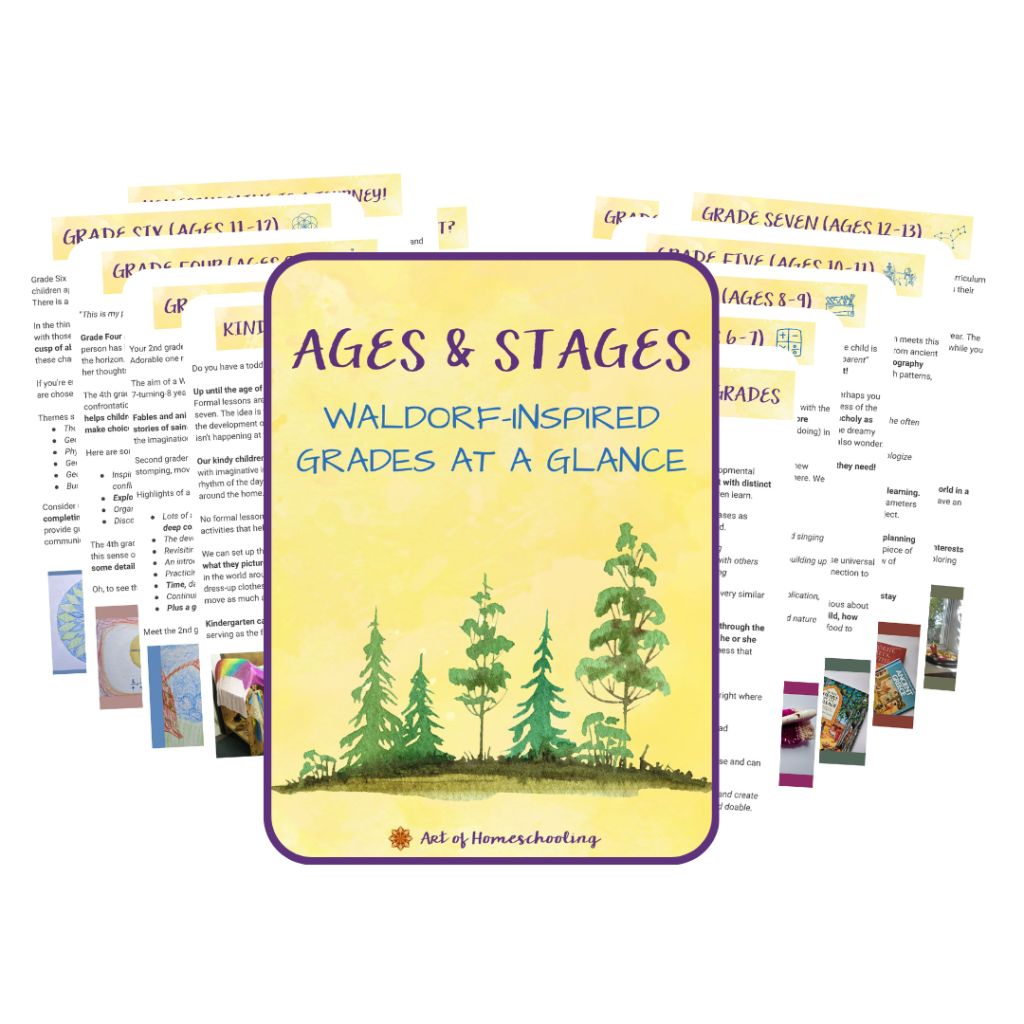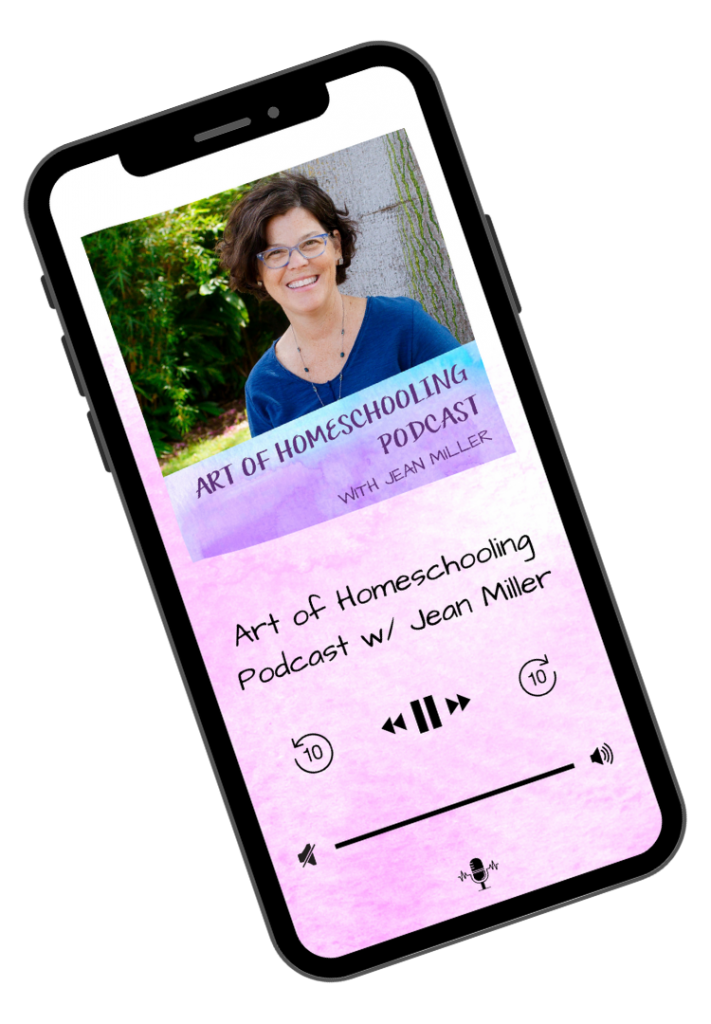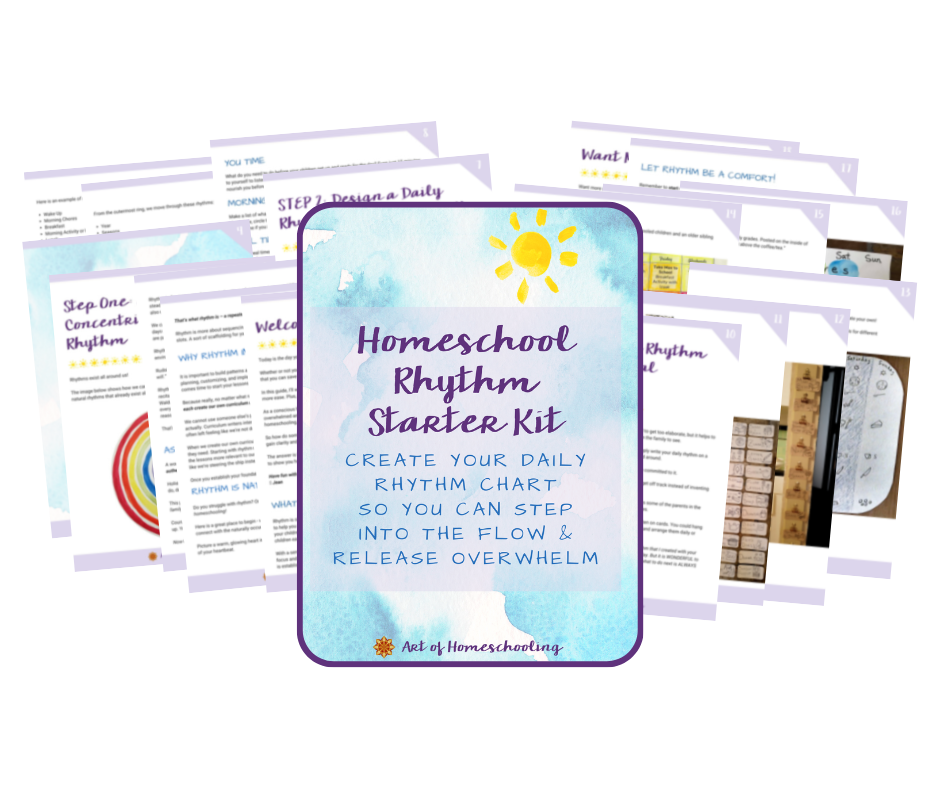Episode 182
You’re in for a treat today because I’m sharing the first in a series of episodes diving deep into each grade, starting with The Kindergarten Basket. I’m excited!
Over the next few months here on the podcast, we’ll be building a wonderful library for you to refer back to, over and over again, whenever you need inspiration and guidance about Waldorf-inspired homeschooling through the grades.
Getting Started with Homeschooling Kindergarten
When my oldest two kiddos were 3 and 4 years old, I went to look at preschools.
It was February and I was going stir crazy at home with two very active little boys.
I’d read an article that suggested I find a child similar to mine and observe how the teacher interacts with him. So that’s exactly what I did.
And what I discovered was that the child most like my active boys was a bit out of sync with the rest of the kids, and the teacher was super annoyed with him.
That’s when it hit me. Kindergarten-age children need time!
Time for free play and time in a nourishing home environment where they can imitate the daily activities of the adults around them.
“I can do that!” I remember thinking.
My husband Brian and I decided to keep our kiddos home during these years so that we could create an environment that was developmentally appropriate for our young boys, full of lots of stories, music, cooking and cleaning, and time outdoors.
Those “kinder” years were the beginning of our homeschooling journey even though I didn’t totally know that at the time!
So today, let’s chat about kindergarten in a homeschool setting. A Waldorf kindergarten encompasses the ages of 3 to 6 years.
The kinder years are a time for learning through imitation and developing oral language.
Remember the traditional rhyme, “One, two, buckle my shoe. Three, four, shut the door“?
The Waldorf-inspired homeschool kindergarten is rich in verses and rhymes like this one and we minimize formal lessons at this age. It’s a time of growth and playful development.
So listen in to this episode of the Art of Homeschooling Podcast. You can catch the highlights and suggested resources in the show notes below.
Ages & Stages of Waldorf-Inspired Homeschooling
Be sure to add Ages & Stages: Waldorf-Inspired Grades at a Glance to your homeschool resource library.
It’s a FREE guide that gives you an overview of each age and stage up to 8th grade.
In the Ages & Stages guide, you’ll find concise descriptions of each grade with a list of themes or main lesson topics, and examples of artwork, main lesson book pages, handwork, and resources.
Waldorf education at its core is a developmental approach. And each age and stage is defined by stories, themes, and skills that nurture children in just the right way to support their unfolding consciousness and encourage growth and learning.
The founder of Waldorf education, Rudolf Steiner, defined three phases of child development. These stages mirror the stages of development described by other educators like Maria Montessori and psychologists like Jean Piaget.
These three stages are:
- Ages Birth to 7
- Ages 7 to 14
- Ages 14 to 21 and up
You’ll often hear these stages discussed as “Hands, Heart, and Head” or “Thinking, Feeling, Willing” in Waldorf circles. And if you’re not very well-versed in these three stages, add Episode #126 to your podcast queue. It covers these three stages of child development and the three ways that children learn best in each stage.
And even if you’ve adopted other homeschool methods like Charlotte Mason or the classical approach, these ideas about child development can still help guide and inspire you. These ideas are really universal.
Your Kindergartener, Ages 3 to 6
Up until the age of about six or seven, children learn best through imitation and action.
With the Waldorf approach, formal lessons aren’t started until first grade, generally the year in which a child turns seven. The idea is that young children need their life force energy for the development of their organs ~ including their brain.
But that’s not to say learning isn’t happening at this stage though!⠀⠀
Our kindy children are watching us, exploring their world, and learning through play with imaginative imitation. This is a time for singing songs, telling stories, marking the rhythm of the day with poems and songs, and playfully engaging in everyday tasks around the home.
No formal lessons yet. But we can share lots of age-appropriate fairy tales and stories and bring activities that help develop spatial awareness, pre-literacy and pre-math skills.
We can set up the home environment in such a way as to encourage children to play-act what they picture happening in the stories they hear and what they observe happening in the world around them.
This can include simple props for pretend play, open-ended dress-up clothes or little animal scenes, squares of colorful fabric or play silks, and plenty of space to play and move as much as possible.
Kindergarten can be play-based and nature-based with everyday homemaking tasks serving as the foundation of our days with our children.
The Kindergarten Homeschool Basket
As mentioned in the episode, here are the resources I find most valuable to have in your kindergarten basket. (Affiliate links included💜 You can read my full disclosure policy here.).
- You Are Your Child’s First Teacher: Encouraging Your Child’s Natural Development from Birth to Age Six by Rahima Baldwin. This lovely book shows parents and educators how to enrich the lives of children from birth to age six. It has ideas for early childhood education, parenting, and using homelife as the curriculum.
- Beyond the Rainbow Bridge: Nurturing Our Children from Birth to Seven by Barbara Patterson & Pamela Bradley
- A Child’s Seasonal Treasury by Betty Jones. This book is full of wonderful verses, songs, games, crafts, fingerplays, and stories for young children organized by the seasons. This treasure was a go-to resource for me in our homeschool for years.
- Kindergarten at Home masterclass inside the Inspired at Home community This masterclass for homeschoolers includes four video lessons, links to resource articles for further reading, and some key bonuses to help you visualize and set up a space and learning activities for your children.
Kindergarten at Home
Throughout the kindergarten years at our house, we had a little farm with animals set up in the living room, a doll house with little people, a play kitchen with lots of cooking props, cloths and blankets for building forts. We also had a yard full of stumps to climb around on and a garden.
The natural flow to our days included stories and songs, time for indoor play, outdoor play, cooking and cleaning, plus rest time.
We had a playgroup once a week and my kids had neighborhood friends to play with in the afternoons.
And learning was happening naturally with all of these simple activities.
This is what kindergarten is all about ~ time for our children to grow and the learning to unfold simply and naturally with nourishment and love.
If you’re just beginning your homeschool journey with kindergarten, I’m so excited for you!
Additional Resources
- In addition to child development, Waldorf-inspired homeschooling also emphasizes the importance of rhythm ~ the rhythm of your lessons, days, weeks, seasons, and years ~ and the lively arts. These three elements ~ child development, rhythm, and the lively arts ~ form the foundation for crafting a homeschool life that you love. To experience how these elements are woven together, check out Episode #179: Homeschooling with Waldorf: Getting Started.
- And don’t miss Ages & Stages: Waldorf-Inspired Grades at a Glance. It’s a FREE & PRINTABLE resource with inspiration for your kindergarten basket and beyond! Going up to Grade 8, this guide will help you zoom out and see the big picture in order to navigate your homeschooling journey, as well as hone in on the essentials for each age and stage. Get your copy today!
And don’t miss other episodes in this Ages & Stages series:
- Kindergarten ~ Episode 182: The Kindergarten Basket
- First Grade ~ Episode 185: The First Grade Basket
- Second Grade ~ Episode 187: The Second Grade Basket
- Third Grade ~ Episode 192: The Third Grade Basket
- Fourth Grade ~ Episode 197: The Fourth Grade Basket
- Fifth Grade ~ Episode 201: The Fifth Grade Basket
- Sixth Grade ~ Episode 204: The Sixth Grade Basket
- Seventh Grade ~ Episode 207: The Seventh Grade Basket
- Eighth Grade ~ Episode 210: The Eighth Grade Basket
Until next time!💜

Rate & Review the Podcast
If the Art of Homeschooling Podcast has inspired you, I’d LOVE it if you could rate and review the podcast on your favorite podcast player! Reviews can be left on Apple Podcasts (iTunes), Podcast Addict, or Stitcher.
Or simply pop on over to lovethepodcast.com/artofhomeschooling and choose where you want to leave your review.
And if you want to show your appreciation for the Art of Homeschooling Podcast, you can buy me a cup of tea!
Never Miss an Episode!
Check Out All the Episodes






I’m teaching First Grade and Kindergarten next year!
Love that! Look for the First Grade Basket episode in a few weeks here on the podcast. 😉